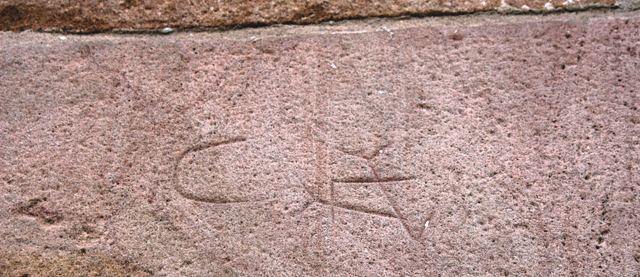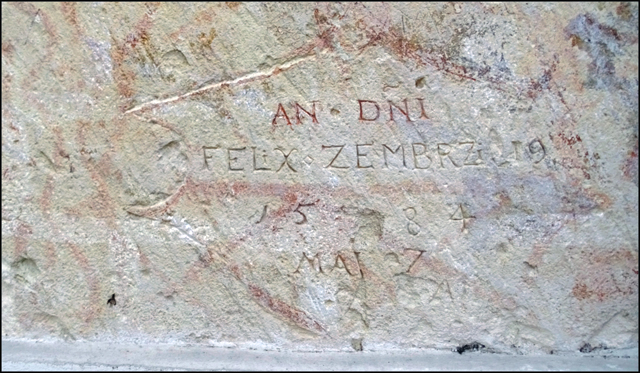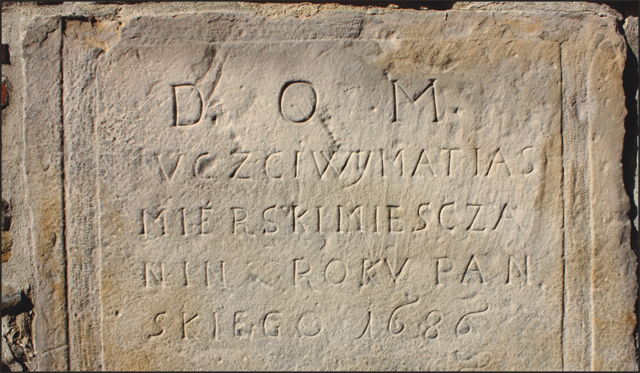WALLS TELL STORIES

While gathering photographic material for my publication “Stone in the Architecture of the Świętokrzyski Region”, I visited a number of architectural sites which were built using rock materials coming from local deposits. Churches are the largest group among these historical buildings. It was in them that I came across strange, somewhat mysterious signs that were preserved on the surfaces of stones from which the sacred buildings were built. They differed significantly from the paintings and engravings we are used to finding in the interiors of churches.
The signs we can see look like some markings or line-shaped characters, often with initials intertwined. They are signs which are fulfilled the role of merchant’s marks and were most often placed on the buildings by their builders. They serve as a kind of signature that plays the role of identification, and it also indicates the author’s status in the local community. They also served as the contractor’s signature ensuring the reliability and guarantee of the services provided. At times when there were no websites promoting the products of a given company, they were exactly these marks that played this role.
The marks served as legally protected trademarks and every craftsman was obliged to register their production mark.
Another type of carved markings were miniature epitaphs which served to give information about people buried in church cemeteries. I found some well-preserved inscriptions on the walls of St. Sigismund church in Szydłowiec, where there are tens of examples of such signs engraved both on the outer wall of the church and on the church wall. This is a type of inscriptions referred to as graffiti. This way, names and dates of people were commemorated who were buried next to the church at the turn of the 16th and 17th centuries and could not afford a separate tombstone.

The making of marks and graffiti was only possible thanks to the properties of the building material from which the structures were built. It was mainly sandstone – both Jurassic and Triassic – as well as the Pińczów limestone, used throughout south-eastern Poland, which was a relatively soft material, especially in the first period after extraction.
A big curiosity found on the church wall of the collegiate church in Opatów were elongated or circular-shaped markings in the sandstone from which the blocks of the building were made. They relate to the pagan ritual of lighting sacred fires. It is a custom which dates back to pagan times and which still prevailed until the 19th century. The fire that was obtained on Holy Saturday before Easter by rubbing pieces of wood against the church wall. This custom, though it had a sacred character in Christianity, dates back to the times of ancient Slavic beliefs.

I would like to encourage all visitors to historic buildings to take a closer look at the walls. Let me assure you that apart from inscriptions such as “I was here” or “I love Betsy”, you will be able to find some unique “gems” from a more distant past.


The Polish word “gmerk” denoting a merchant’s mark comes from the German Gemerk (sign) and refers to a personal or family sign placed on objects, products, or structures. Originally, it was a pottery and stonemason’s mark with which craftsmen marked their work.
The oldest marks date back to ancient Greece, where they can be found on stone elements of buildings. They were probably first used to mark elements for the purpose of facilitating assembly. From the mid-12th century onwards, their use was common with construction workshops.
The marks eventually became an equivalent of the coats of arms used by burghers. They were placed on signets, seals and a variety of craft products.
The marks served the purpose of a signature, and they had three functions: identifying, legal and commemorative.
The legal functions include: a proprietary mark, a producer’s mark – a craftsman’s guild (a producer who cares about the brand of the products safeguards the trademark which symbolises it). For this reason, the production marks stood under protection by the law, and each craftsman was obliged to register a mark by statutes of the guild.
In its commemorative function, the mark was to serve as remember the owner in places where, for aesthetic reasons or simply for lack of space, a signature could not be placed.
Source: Kurier kamieniarski
Author: Jerzy Jędrychowski | Published: 17 September 2018
